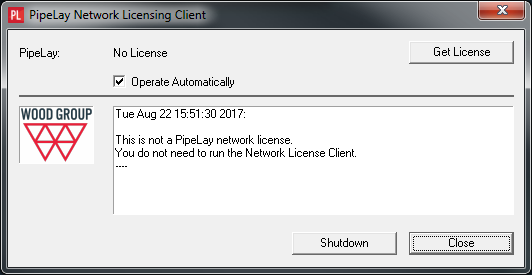The PipeLay Network Licensing Client is a small applet that allows the user to attach to a Network License Server and get a license for PipeLay. It is installed automatically along with the rest of the PipeLay.
If your PipeLay software license agreement allows you to use network licensing, you will have been issued with a network version of the software license file (MCScode), and the Network Licensing Client should start automatically when you start PipeLay.
When the Network Licensing Client starts, it displays a small icon in the notification area of the Windows™ taskbar, as shown in the figure below.
Network Licensing Icon
This icon is similar to the PipeLay program icon overlain with one of three symbols. A red ý, as shown above, indicates that you do not currently have any licenses. A green þ, on the other hand, indicates that you have obtained a license for PipeLay from the License Server. A black question-mark symbol indicates that the Network Licensing Client is searching for a license.
Double-clicking on the icon displays the Network Licensing Client dialog window, which is described next.

Network Licensing Client
Your current PipeLay licence status is listed at the top of the dialog window. The name of the license server from which your license was obtained is also listed; in the picture above, it is a server called ‘Hardware Dongle Server’. There is also a button to allow you to manually get or release a license; its use is described in the following section, entitled ‘Automatic and Manual Operation’.
In the middle of the dialog is a check box that allows you to select whether or not the Network Licensing Client will operate automatically. It can operate either manually or automatically; these two modes of operation are described in the following section. For most users, Operate Automatically is the more convenient mode.
On the lower section of the dialog, there is a status area in which messages are displayed, with a time stamp. If you have a problem getting a license, you should open the dialog and check to see if an error message is displayed in the status area.
At the bottom of the dialog, there are two buttons, Shutdown and Close. Shutdown releases any licenses you may have at present, and terminates the Network Licensing Client. Close simply closes the dialog; you can open it again by double-clicking on the icon in the Windows™ taskbar.
You can choose whether to have the Network Licensing Client operate automatically or manually, by selecting or de-selecting the Operate Automatically option. As stated above, automatic operation is more convenient for most users. However, ‘power users’ may prefer to use manual operation, for example to hold on to a license between analysis runs.
With automatic operation, the Network Licensing Client requires no user intervention. When PipeLay requires a license, it automatically requests one. If there are no licenses available, or if there is some other error, it will display a message to inform you. Otherwise, it will proceed to perform the analysis. When PipeLay exits, it automatically releases any licenses and shuts down the Network Licensing Client.
With manual operation, PipeLay cannot request licenses automatically. Instead, you must use the Get License and Release License buttons. Neither can PipeLay shut down the Network Licensing Client automatically; you must do this manually using the Shutdown button. However, if PipeLay needs a license, or if the Network Licensing Client is no longer required and may be shut down, a message is displayed in the status area advising you of this fact.
As stated earlier, the Network Licensing Client starts automatically when you run PipeLay. However, you can also start it manually by double clicking on the client.exe in the PipeLay bin folder.